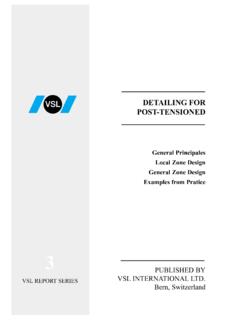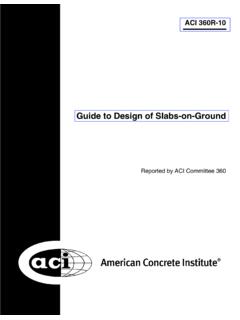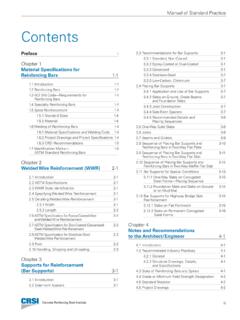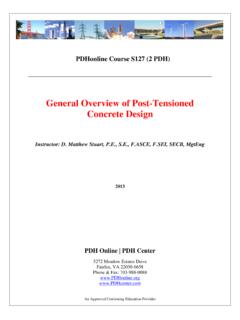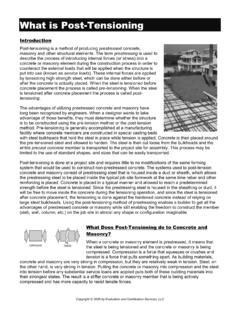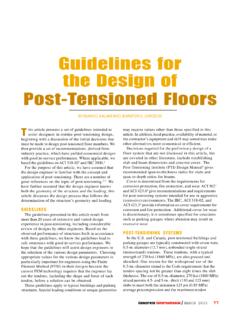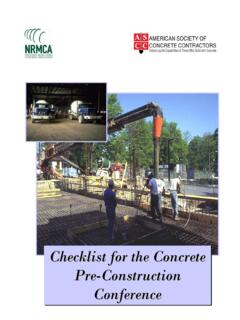Transcription of POST-TENSIONED IN BUILDINGS - STRUCTURAL …
1 REPORT SERIESPOST-TENSIONEDIN BUILDINGSG eneral Objectives in building DesignApplications of post -Tensioningin building StructuresThe VSL Hardware for Use in BuildingsDetails and Layouts Improving theConstructabilityPreliminary Sizingof POST-TENSIONED FloorsExamplesPUBLISHED BYVSL INTERNATIONAL INBUILDINGSP refaceThe development of reliable prestressing techniques has certainly been the most importantinnovation in the field of STRUCTURAL concrete. It enabled concrete construction to competesuccessfully within areas that had previously been dominated by steel construction, including long-span bridges, high-rise BUILDINGS , pressure vessels and offshore , prestressing and, in particular, post -tensioning is a mature technology, providingefficient, economic and elegant STRUCTURAL solutions for a wide range of indicate vast differences in the use of post -tensioning among different the wide spread can largely be explained by differences in local needs, standards,education and habits it appears that the potential offered by post -tensioning is far frombeing exploited, especially in building structures.
2 Too many building structures, for whichpost-tensioning would provide a clearly superior solution, are conceived, designed and builtas non -prestressed. For too long, non-prestressed and prestressed concrete have beentreated as completely seperate entities and hence, prestressing is not yet regarded as afamiliar and desirable construction option by many developers, architects, engineers in BUILDINGS is not limited to floor slabs. post -tensioning of foundations,transfer beams and plates, POST-TENSIONED masonry and the combination of precast elements with cast-in-place concrete by means of post -tensioning offer other interestingopportunities. Developers, architects, engineers, contractors, educators and students willfind the present report to be most informative in this regard.
3 It describes the application ofpost-tensioning within the overall context of building construction and it yields a sufficientbasis for corresponding preliminary designs; special information required for the finaldimensioning and detailing will be given in a companion should be commended for continuing their tradition to disseminate state-of-the art information on post -tensioning and it is hoped that through this and related efforts anincreasing number of companies and individuals will benefit from the use of posttensioningin , 30th April 1992 Prof. Dr. Peter MartiETH ZurichPOST- tensioned Objectives in the Design of building Structures of post -Tensioning in BUILDINGS Floor Systems.
4 Moment-Resisting Frames . Transfer Beams and Transfer Plates Wall Panels and Service Cores POST-TENSIONED Foundations and Ground Anchors POST-TENSIONED Masonry Walls Other Applications VSL hardware for Use in building Structures The System To Grout or not to Grout? Sizing of POST-TENSIONED Floors Improving the Constructability of POST-TENSIONED Floors ..37 Authors:Franz A. Zahn, PhD, Dipl. Ing. Hans R. Ganz, Dr. sc. techn., Civil Engineer ETHC opyright 1992 by VSL INTERNATIONAL LTD., Switzerland -All rights reserved - Printed in Hong Kong1 POST-TENSIONED INBUILDINGS1. IntroductionIt is no secret that the key to the successfulconstruction of new BUILDINGS is successfulplanning. Successful planning starts from thevery beginning with good communication andclose cooperation between all parties involvedin the project, in particular the owner, thearchitect and the engineer.
5 As soon as acontractor has been nominated he too shouldbe included in the planning team. In this wayone of the key aspects of successful planning,the constructability of the building , can beaddressed properly as part of theevaluation process of various concepts. This isof paramount importance for the success ofthe project since constructability mostmarkedly affects the time to completion of aturn-key project and thus the final cost to theowner. Because the major part of the total costof large developments is financing cost ratherthan actual construction cost, the completiontime is often a more important considerationthan material consumption. With this in mind itfollows that successful planning means toalways maintain an overall perspective of theproject, that is to consider the building as awhole rather than looking at individual parts inisolation.
6 Since the various parts of a buildingstrongly influence oneanother, in particular inthe way they are constructed, optimization ofone part may well be detrimental to , in particular in the way they areconstructed, optimization of one part may wellbe detrimental to when considering only the constructioncosts (Fig. ), it is evident that optimization ofstructural material consumption alone will resultin relatively modest overall savings since onone hand the STRUCTURAL cost makes only about30 to 50% of the total construction cost and onthe other hand more than half of the structuralcost is labour cost, related mainly to significant saving in construction cost cantherefore only be achieved by means that alsoaffect the labour cost and the non-structuralcost for cladding, electrical and mechanicalservices, lifts, fit-out, most cost significant STRUCTURAL element of abuilding is the floor framing.
7 Fig. the relative contribution of thefloor framing to the total STRUCTURAL cost per unitfloor area. While for low-rise BUILDINGS thiscontribution is almost 100 %, the cost forcolumns and walls including their foundations,and for the lateral load resisting systembecomes increasingly significant for tallerbuildings. The floor framing system affects thecost in two ways:First it has a direct influence on the rest of thestructure in that its weight determines the sizeof columns, walls and foundations, and itsstructural depth determines the total buildingheight and thereby the quantity of claddingand vertical trunk lines. In seismic areas thefloor weight also determines the member sizesof the lateral load resisting system.
8 Fig. the split-up of the total STRUCTURAL weightof a 49-storey building . While the floor framingaccounts for just over 50 of the total, any reduction of floor weight would cause acorresponding weight reduction also for the peripheral frames and the service core andwould thus affect almost the entire second way the floor framing systemaffects the cost of the building relates to thetotal construction time: Both the time required toconstruct one floor and the time lagbetween the STRUCTURAL completion of the floorand the commencement of fit-out work such aselectrical and mechanical services,suspended ceilings and decorating, are majorfactors influencing the time to completion of thebuilding.
9 These considerations demonstratethatthe optimization of the floor framing with regardto weight, STRUCTURAL depth and constructabilitygoes a long way towards successful , one should not make the mistake ofcomparing the cost of one floor system againstthe cost of another without considering the arryover effects on other parts of the structure,including the non- STRUCTURAL parts, and onfinancing some countries, including the ,Australia,South Africa and Thailand, a great number oflarge BUILDINGS have been successfullyconstructed using posttensioned floors. One ofthe main reasonsFig. : Contribution of Floor Framing to Total STRUCTURAL Cost [1]Fig. : Split-up of Total Cost for BuildingsLabourLabourLabourLabourMateria lMaterialMaterialMaterial2 POST-TENSIONED INBUILDINGSfor this success is the improved constructabilityof POST-TENSIONED slabs: less material to bohandled and placed, simpler and lesscongested reinforcement, earlier stripping offormwork and often simpler formwork.
10 Apartfrom shorter overall construction time andsavings in material and labour cost, post -tensioning allows more architectural freedom:Larger columnfree spaces providing moreflexibility in the subdivision of commercial andoffice floors, wide-spanning or boldlycantilevering floors that leave generous spacefor lobbies or public areas, slender elegantroofs for show rooms or exhibition halls, toname a few : Split-up of Total STRUCTURAL Weight for a 49 Storey Office building of the "Tube-in-Tube" Type (adopted from [2]In addition, the reduction of STRUCTURAL heightand weight as outlined above, and theimproved deflection and cracking behaviourcontribute to the success of shows the total post -tensioningconsumption and the percentage used inbuildings in various countries in the year is evident that there are huge in the and Australia more than 75 %of the total posttensioning was built into buildingstructures, this market made less than 10 % inmost European countries.)
